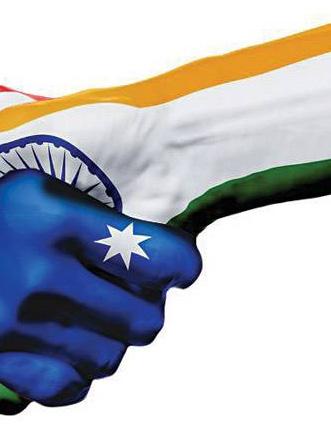
14 minute read
India News-JGU-IAIE SMART program
The Great Barrier Reef
The Great Barrier Reef (GBR) is located on the north-east coast of Australia, off the coast of Queensland. It covers an area of 348,000 square kilometres. Its unique ecosystem earned it the title of a World Heritage Site in 1981. When it comes to biodiversity, GBR has one of the richest, most organic and complex ecosystems on earth. It comprises the world’s largest collection of corals (over 400 types), 4000 types of molluscs, and 1,500 species of fish. The beauty of the GBR can be fully captured from an aerial view, and it is the only living structure visible from outer space. An aerial view would reveal mosaic patterns of reefs and a seascape panorama depicting corals of diverse shapes and sizes. Beneath the surface, one can find a marvellous assemblage of hard and soft corals, thousands of brightly coloured reef fish, and the special Cod Hole near the Lizard Island.
Advertisement
Recently, UNESCO decided to label the reef as “in danger”, and the Australian government lobbied to delay the decision. Such an act downplays the danger that the reef faces, as it has been experiencing massive bleaching recently. In 2016, it was suspected that 29-50 of the coral reefs were degraded due to bleaching. It is important that humankind preserves this natural living habitat, especially since a healthy ocean is crucial for a healthy planet, and coral reefs form an important part of the ocean biodiversity.
Such regions are in danger due to the effects of climate change. As we continue to emit greenhouse gases, flora and fauna continue to be destroyed. Due to greenhouse gas emissions, the tropical sea surface temperatures have risen by approximately 0.4-0.5 degrees celsius since the 19th century, which has made it difficult for the plant and animal species to adapt due to heat stress and mass coral bleaching. Since the 18th century, the earth’s oceans have absorbed around 30% of the additional CO2 which has been released in the air. This has led to acidification of the ocean, indicated by reduction in pH levels.
On the bright side, there are signs of recovery in over 60% of the reef. This, however, should not lead us into complacency, as the impact of coral bleaching is not visible till after few years. Nevertheless, that one of the greatest living structures on earth is reviving itself is a welcome news.

Deepening Australia-Japan bilateral ties
On 15 July 2021, the Australian Minister for Trade, Tourism, and Investment, Dan Tehan MP, and the Japanese Minister for Economy, Trade, and Industry, Mr. Kajiyama Hiroshi, cochaired the third Japan-Australia Ministerial Economic dialogue in Tokyo. This symbolises deepening bilateral ties between both countries. Discussions revolved around shared opportunities and challenges, including economic recovery from the catastrophic impact of COVID-19 on the IndoPacific region. The dialogue was characterised by emphasis on shared values such as assurance of free and fair trade and strengthening of a rules-based multilateral trading system, among others.
The two countries also reaffirmed their commitment to achieving net-zero transmissions under the Japan-Australia Partnership on Decarbonization through Technology. They also agreed to extend such initiatives to neighbouring countries to mitigate global emissions, and to prioritise helping the Association of Southeast Asian Nations (ASEAN) meet their emission goals. The representatives from both sides pledged to address unfair trade practices to enhance supply chain resilience. Both countries also stressed the need for developing quality infrastructure in the IndoPacific region and affirmed to coordinate in dealing with digital technologies. This includes a covenant to build enhanced modes of information exchange to mitigate difficulties arising from development and usage of digital tech and critical infrastructure.
Being participants in the Comprehensive and Progressive Agreement for Trans-Pacific Partnership (CPTPP) and the Regional Comprehensive Economic Partnership (RCEP), both countries reiterated their interest in strengthening their economic partnership in the wake of the pandemic. Under the

CPTPP, both countries committed to maintaining the rules of the partnership and providing support to signatories that have not ratified the agreement yet. With regard to RCEP, the representatives emphasised the importance of early implementation of the agreement. These strengthening bilateral relations signify the desire of Japan and Australia to reduce their dependence on Chinese supply chains in a post-pandemic world in a mutually beneficial way, and their commitment to create a positive impact in the Indo-Pacific region.
Similarity between adivasis of India and aborigines of Australia
India is home to various tribal and indigenous communities, which remain unaffected by modern living compulsions today. India possesses the highest tribal population in the world, with a whopping 84.4 million recognised tribal communities.
Tribal people in India are known by the word ‘adivasi’, meaning ‘local inhabitants’. They are economically backward, and still dependent on traditional methods of livelihood suchas hunting, agriculture, fishing and cattle breeding and raising. The major tribal groups in India include Bhils, Gonds, Santhals, Khasis, Kols, Anganims, Bhuitas and the Great Andamanese. These different ethnic groups have their very own traditions and cultural practices, with different languages and lifestyles.
The Indian Constitution has not provided adequate clarity on the definition of ‘tribe’, but they are listed by the government in the Constitution under ‘Scheduled Tribes’. Academics and anthropologist have been making efforts to agree a single definition of a tribe. For example, sociologists define a tribe as a “social group, usually with a definite area, dialect, cultural homogeneity and unifying social organisation.”
Over the years, tribal structures and identity in India have been affected by ‘mobility and change’. With extra-regional movement in search of livelihood tribes have taken up peasantry and labour, and are working as waged labour in industries, plantations and the mining industry. In this situation the concept or definition of tribe will have to be a bit broader to include their changing socioeconomic activities driven by mobility and development. In Australia, the time and place of the arrival of the first humans in and around the continent is a subject of debate among scholars and historians. The earliest archaeological evidence of human remains have been found from around 50,000 years ago, of the Mungo Man LM3 and Mungo Lady. But recent archaeological evidence derived from charcoal and artefacts reveal that the tribes in Australia date back to 65,000 Before Present.
In the Australian continent, there used to exist more than 500 different ethnic “clans” that formed a nation in themselves, incorporating many distinctive socio-cultural structures, beliefs and languages. The equivalent of tribal people in Australia consist of 2.4% of the total population. Like ‘adivasi’ in India, the term ‘aboriginal’ or ‘Torres Strait Islander peoples’ (plural) is used to refer to indigenous groups in Australia.
Before modern-day boundaries were drawn, indigenous peoples migrated across continents and circumvented ancient coastlines and reaching Australia passing through India. This perhaps explains the similarity between the tribes of different parts of the world. SBS executive producer Kumud Merani has examined in her radio special of 2014, the significant links between the tribes of India and Australia, which go back thousands of years. Science and genetics have played a crucial role in casting new light on these arguments. However, there is still a lot to be learnt about what drove people to migrate so far and wide. Was it for richer hunting and fishing grounds, or simply their unsatiated quest to see what lay beyond the next beach or the nearest mountain range? There is so much we still do not know about the early humans.

Shivam Shukla
Sri Lanka’s bid for a BIMSTEC Summit
When Narendra Modi was sworn in as the Indian Prime Minister for the second time in 2019, he invited representatives from the Bay of Bengal Multi-Sectoral Initiative for Economic Cooperation (BIMSTEC) nations - Bangladesh, Bhutan, Malaysia, Sri Lanka, Thailand, Nepal - to witness. This change of attendees, from the previously invited SAARC member nations, signalled a shift in focus from a regional group primarily, defunct due to Indo-Pak tensions, to one that has immense potential for regional security and connectivity. BIMSTEC began as an initiative for mutual trade and economic growth, but now extends to tourism and sports, counter-terrorism, development of information technology, military exercises, Humanitarian Aid and Disaster Relief (HADR), and much more.
Sri Lanka, the current Chair of BIMSTEC has proposed to conduct the BIMSTEC Summit in December 2021, after multiple COVID-19 induced postponements in 2020. This summit carries high hopes for the member nations, considering its agenda items include finalising the Charter of BIMSTEC, the BIMSTEC Coastal Shipping Agreement, which aims to promote and expand coastal shipping in the region, the BIMSTEC Motor Vehicles Agreement, which is meant to make passage of cargo and motor vehicles across borders easier, and the BIMSTEC Master Plan for Transport Connectivity, which will be a “strategic document that guides actions and promotes synergy among various connectivity frameworks.”
An elaborate agenda for the Summit has already been discussed during the 17th BIMSTEC Ministerial Meeting conducted among the Foreign Ministers of BIMSTEC member nations on April 1, 2021. The next step, however, should be to rejuvenate and conclude the BIMSTEC Free Trade Agreement, which, since its inception a decade ago, has been operationalized very slowly. However, apart from furthering intra-BIMSTEC trade, an FTA will also create mutual trust for a time when BIMSTEC nations will jointly negotiate trade and commerce agreements with other national or regional entities. Another significant aspect, as also mentioned by Indian External Affairs Minister S. Jaishankar in his address to the 17th Ministerialmeet, will be mitigating the climate crisis. BIMSTEC nations, by virtue of being located close to massive water bodies and vulnerable to global-warming induced environmental variations, must find collective means to engage in Humanitarian Assistance and Disaster Relief (HADR) and exchange of technological infrastructure for understanding weather anomalies.
There is a lot to look forward to at the 5th BIMSTEC Summit which may enable closer cooperation. With a charter in place, the BIMSTEC Secretariat will be empowered to make far-reaching decisions, thereby legitimising the organisational structure, and furthering scope for freer regional trade and safety.
India-Australia energy ties

Energy has great potential to become the defining aspect of the India-Australia partnership in a few years. Given India’s high rates of urbanisation and infrastructural development, its energy demand is growing manifold. The cooperation between the two countries can play a major role in this regard. Australia has an abundance of fossil fuel reserves and expertise in harnessing renewable energy. Today, India needs a diversified source for hydrocarbon imports, and Australia will be instrumental in this regard. Collaborative India-Australia research centres on energy will act as a major platform for exchange of scientific practices and engineering solutions focusing on both fossil fuels, and renewable sources of energy. The objectives of such joint research facilities could include not just exchange of knowledge and on-going efforts, but also training exchanges for technical personnel, usage of shared facilities for energy production and consumption, and working on joint publications and patenting.
India and Australia, along with other members of the Quadrilateral Security Dialogue, can also create a regional economic hub centered around clean and affordable energy. Such cooperation would immensely benefit both the countries and the region.

Dhruv Jha
Tokyo Olympics 2020: Many firsts and the repetition of history for India
The 2020 Tokyo Olympics have witnessed several records being broken across fields of sports. At present India stands at a medal tally of 7, with 1 gold, 2 silver and 4 bronze medals.
Mirabai Chanu won the Silver medal in the women’s weightlifting (49 kg) category, competing against China’s Hou Zhihui. She won India’s first medal at the 2020 Tokyo Olympics, and simultaneously, the first Olympic medal in weightlifting for India in 21 years since Karnam Malleswari won the bronze medal at the 2000 Sydney Olympics.
Another silver was secured by Ravi Kumar Dahiya in the men’s wrestling (57 kg). He played against Russian counterpart ZavurUguew, and bagged India’s second silver medal at the Tokyo Olympics 2021. This is the second of two silver medals Dahiya has won, the first of which he secured at the 2012 London Olympics.
Lovlina Borgohain, a boxer was placed third in the welterweight category. By securing the bronze medal, she has become the third individual to secure an Olympic medal in boxing after Vijender Singh and MC Mary Kom, both of whom won a bronze medal for India in the 2008 and 2012 Olympics, respectively. This Olympic medal has been won by the 23-year-old Borgohain in her Olympics debut.
Another bronze medal was secured by PV Sindhu in the women’s singles badminton event. She lost to Taiwanese player Tai Tzu-ying in the semi-finals. However, Sindhu came back up stronger and won the bronze match by defeating China’s He Bingjiao. Further to her previous win of silver medal at the 2016 Rio Olympics, Sindhu became the first Indian woman Olympian to secure two medals consecutively in the games.
Another bronze medal was won by the men’s hockey team beating Germany 5-4. This win was the first in 41 years after the last gold medal was won by the men’s hockey team in the 1980 Olympics. The women’s hockey team fought hard but narrowly missed the bronze medal. Stillthey created history by reaching the semi-final since women’s hockey was introduced in the 1980 Moscow Olympics. Similarly, Aditi Ashok, a progolfer, ranked 200th in the world was amongst the top four all through the four rounds, but narrowly missed bronze by a single shot, winning India’s hearts.
7 August, 2021 was a historic day when Bajrang Punia bagged a bronze medal in the men’s freestyle wrestling (65 kg category) and Subedar Neeraj Chopra VSM, secured India’s first ever gold medal in athletics, in Javelin throw. Neeraj became the second Indian to win a gold medal, after Abhinav Bindra,who had won gold in shooting at the 2008 Beijing Olympics.

Shri Khyati Reddy
Who’s looking after Australia’s healthcare workers?

Sumedha Maheshwari
Healthcare workers across Australia are struggling as the COVID-19 Delta variant rages on. The latest surge has forced hundreds of critical care workers to go into lockdown in Queensland, followed by a week-long lockdown in Victoria, yet again. In Sydney, a major hospital and two nursing homes were hit by the outbreaks that forced healthcare workers into isolation. Thirty-six staffers of Westmead Hospital went into quarantine after one of their vaccinated colleagues tested positive after working three shifts last week. Three staff members in Sydney and Blacktown nursing homes have also reportedly tested positive for the virus.
These numbers are extremely concerning as these workers are at the frontline of pandemic response. If they are unsafe, what about patients? According to a study published in BMJ Leader, the official journal of the Faculty of Medical Leadership and Management, there is a limited supply of PPE kits for healthcare workers, which has led to rationing and reusing. The PPEs are of lower quality, with masks and gowns that tear easily. Internal support is also lacking, as medical authorities are unable to remain accountable.
A troubling poll by the Royal Melbourne Hospital found that anxiety, burnout, and depression rates among 10,000 healthcare workers were 61%, 58%, and 28%, respectively. They are crumbling under pressures of mental health degradation. Adequate attention is not being paid to those who are tending to others.
Vaccine rollout in Australia has been slow, too, with shortages of the Pfizer vaccine shots and fears surrounding the AstraZeneca jab. Only 15% of the population has been inoculated with both doses, with 17% receiving one dose only. Many health workers are also facing problems with the Australian immunisation register. The errors in vaccine data showed the status of some as one dose when they were already fully vaccinated and vice versa. Vaccine data is the most significant advantage in the fight against COVID-19, and so these issues do not bode well.
There are many disturbing stories about COVID-19 infections spreading in hospitals and clinics as safety measures are improper. Faulty or inferior PPE kits and a lax approach to guidelines has led these workers to be impacted drastically. There is a lot to be desired for their safety in the current scenario. They seem to be lacking essential protection while caring for others and are now falling sick as a consequence. It is time to help the selfless by overhauling current subpar medical ethic mechanisms and putting up ones that benefit them. They need an operational support structure in place and adequate safety gear. Without them, Australia will only suffer more.










